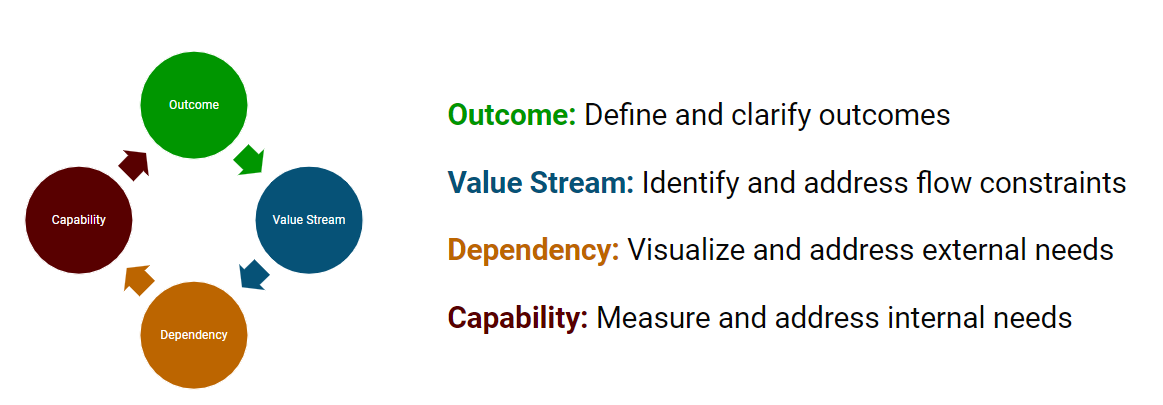Introducing xodiac XPRS on xprs.xodiac.ca, a solution designed to address project delays, cost overruns, and quality concerns
Introducing xodiac XPRS on xprs.xodiac.ca, a solution designed to address project delays, cost overruns, and quality concerns
Flow Engineering
Flow Engineering is an approach to rapidly understanding where to focus and improve value delivery within your organization. Our clients see immediate value and alignment. The output of Flow Engineering is a series of interlinking maps that make where to focus visible. It can be thought of as a highly collaborative assessment of your end-to-end delivery process.
The initial engagement will be a discovery workshop to identify the value streams to be mapped and set the overall outcomes of the engagement. We will also identify the stakeholders for each phase of the Flow Engineering practice. To complete the Flow Engineering process takes 6-8 weeks though you will start to value even from the initial discovery session. A diagram showing each of the stages is in the "What to expect" section at the bottom of this page.
What problem does it solve?
Within an organization, it can be hard to determine where the most effective place is for you and your team to focus to improve service quality. To successfully deliver value quickly, we must first align ourselves with what needs to be done. Visually collaborating on these tasks will help us work faster so that our customers are never disappointed again!
Whether you are looking to adopt Agile, DevOps, or Value Stream Management, you need visibility into where to focus to create tangible results. Flow Engineering gives you that. At the end of the engagement, you and your team will have alignment on their goals and the next steps to take to unlock 10x performance.
What's covered?
The core of Flow Engineering consists of 4 mapping exercises designed to lead into each other. These are:
Outcome map
Value Stream map
Dependency map
Capability map

We supplement these core maps with other exercises to further enhance clarity and alignment. The Flow Engineering framework's final result is a flow roadmap, a guide on where to focus on improving your value delivery practices.
There are three phases to the Flow Engineering implementation:
Flow Engineering steps 1-3 - Identify outcomes and current state constraints
Flow Engineering Steps 4-6 - Understand future state and encompass external dependencies
Flow Engineering Steps 7-9 - Analysis of capabilities and prioritization
At the end of each phase, we provide feedback to stakeholders about the findings. Following the completion of the entire engagement we present and walkthrough the flow roadmap with the stakeholders.
What to expect
Discovery Map
We run through the engagement, clarify any questions and verify stakeholders. We confirm the schedule and initial participants for the follow-on workshops. The session is interactive and serves as an introduction to the collaborative work style we use.
Outcome Map
The first of our workshops is about beginning with the end in mind. We guide you through a series of interactive activities to create your North Star, define obstacles, and convert those obstacles into outcomes. The final step is to collate those outcomes to build an outcome map to guide the subsequent exercises.
Value Stream Map
We visualize your current value delivery process. This exercise identifies constraints and highlights where to focus improvement efforts. We identify any immediate opportunities for improvement. Expect at least a 20% improvement by making the work visible, creating clarity and alignment across teams.
Ideal State VSM
At this stage, we take the group outside their usual ways of thinking and work through an exercise to help them visualize an ideal state, free from constraints. We conduct this exercise to help generate ideas and open stakeholders' imagination ahead of the next stage.
Future State VSM
The objective now is to create a 3-6 month target state for the value stream. The exercise draws upon ideas generated in the ideal Value Stream Map and uses these to extend the current state Value Stream Map, building a set of concrete next steps to improve flow.
Dependency Map
Now that we have a set of defined next steps to improve flow in your value stream and aligned to your target outcomes, we look externally to the value stream to capture any dependencies. We look to capture security, compliance, architecture, and other safety concerns.
Capability Map
The Capability Map is an exercise we use to identify strengths, weaknesses and gaps in the skills and systems needed to create the value stream described above. The activity also identifies the action steps we can take to close any gaps.
Prioritization Map
Through the exercises we've conducted, we will have gathered a large number of action items. To fully visualize the Flow Roadmap, we need to prioritize these steps. We consider factors such as risk, cost, value, time and impact to guide its creation.
Flow Roadmap
The Flow Engineering framework's final step is to visualize all the items we have discovered in the flow roadmap. Visualizing all of the outcomes together creates even more alignment between stakeholders and opens up further discovery opportunities.